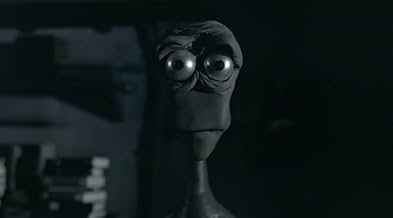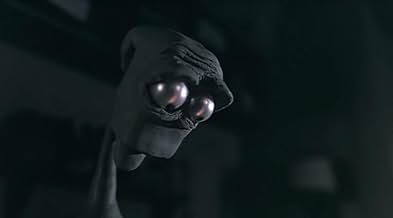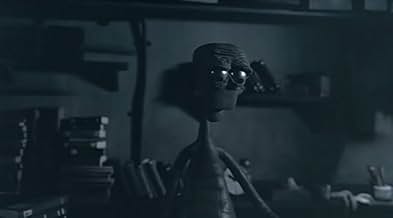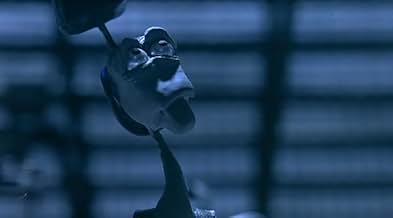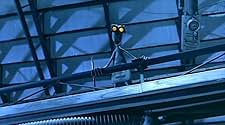More
- 1998
- 6min
VALUTAZIONE IMDb
8,1/10
6278
LA TUA VALUTAZIONE
Un lavoratore di una fabbrica crea un paio di occhiali che induce chiunque li indossi in uno stato di assuefazione. Ma è davvero quella la vera felicità?Un lavoratore di una fabbrica crea un paio di occhiali che induce chiunque li indossi in uno stato di assuefazione. Ma è davvero quella la vera felicità?Un lavoratore di una fabbrica crea un paio di occhiali che induce chiunque li indossi in uno stato di assuefazione. Ma è davvero quella la vera felicità?
- Regia
- Sceneggiatura
- Candidato a 1 Oscar
- 9 vittorie e 3 candidature totali
Recensioni in evidenza
I pride myself on judging every film on it's own, trying not to let others sway my opinion, so when I stumbled across "More" with it's accolades on a web site I was skeptical. But WOW. It's just one of those moments you can't quite figure out *why* you thoroughly enjoy something but you do. Obviously the shots are beautiful and the music heart rending, but you get the feeling much more is under the surface.It's clear that Mark Osborne, like the protagonist of the film, poured his soul into this project dedicating it to his wife and daughter. If you haven't watched it yet, get with it! It's SIX freakin' minutes!
One of the most beautiful and poignant animated shorts I've ever seen, if not the most. Unfortunately, I got to see it only once and didn't get a chance to fully take it in, and there was definitely a lot there to take in. Some beautiful animation and a beautiful story about what happiness really is. Full of symbolism and a look at a future which may not be far off. Shows that happiness doesn't come in a box or any other sort of artificial means. Something which most of the world doesn't and probably never will get.
10dynea
Everyone wants, expects, and demands more and more each day. We think we will get happier and richer by asking, giving and getting more. Are we though? Where is this taking us? This short film is very thought provoking. One can interpret it in multiple levels: political, religious, social etc. Politically there is subtle undermine of how it is almost impossible to rebel against the system. The workers of a factory in this film representing the workers of a capitalistic country who are like ants working their lives off in being productive and efficient to satisfy the demand of their consumptive society. These 'aunts' being controlled and pressured by others above them get worn out, ending up neglecting the meaning of life. Consequently, life seems dark, just like the colors of the film.
The religious implication is the sacrifice of the one for the benefit of the whole. In Christianity, Jesus Christ gave up his life to salvage humanity from the darkness of sin. In this short film, the main character gives up himself to salvage humanity from darkness. He opens 'the door' of his abdomen as if it was the gateway to his soul, taking out and giving to humanity the most precious part of his existence; his colorful soul. That is what it takes to make a change in our society.
As about the social implications, they are multiple. One of which is the monotonous routine the average blue-collar worker has in a developed capitalistic country. Waking up in the morning, going to work, doing repetitious work, getting pressured by the boss, going back home to sleep and repeat the same the next day and feel like nobody among the millions others.
In addition, regardless of the social status of each person, every adult is assigned with certain responsibilities and is expected to behave in a certain manner. Adults are not carefree and cannot act freely upon their feelings. Therefore, dreaming becomes a rescue zone. One is truly free in dreams, thus happy. The main character dreams about his childhood, the time he was carefree and happy. Becoming so nostalgic of the colorful times of his past, he turns into a restless and rebellious person, yearning to bring change into his dark world. He is determined to bring color and happiness back to life, regardless of the cost.
The cost of dreams is a notion highlighted by the director. Everyone has dreams. The demanding society we live in however, does not give us a lot of space to act upon them for free. Those who act upon them, have to sacrifice their lives in one way or another, whether that is the psychological, personal, financial, or even the physical aspect of their lives. How many get sick physically or psychologically from stress running after their dreams? How many drown in debt investing in their dreams? How many spend less and less time with their loved ones ending up losing them to get closer to their dreams? No one can make a dream come true without paying a price for it.
The main character ends up giving up his entire existence, body and soul, to bring this change in his world. His body represented as a piece of coal, and his spirit represented by the brightness of the red color coal which brought brightness, color, and happiness back to the world. It is interesting to note how the memories of his carefree, naive, and happy childhood has the same color as the pieces of the coal representing his soul.
The bottom line is that the main character succeeded in bringing change. Color and happiness was brought back to the world. However, the price was more than he expected. It cost him his life. Was it worth it? Probably it was for him. He finally sensed the almost forgotten feeling of happiness outside his dreams. He once again saw color in life - a notion pertained only to childhood before his sacrifice. Not only did he make himself happy, but he also endowed everyone else with happiness. He saved humanity from darkness. The question is what will happen after him? Will the rest of the individuals get inspired by him and follow his steps or are they going to follow the flock already organized for them for a dark, monotonous, meaningless ride on the road of life. It is a personal decision whether one will live to work or work to live. Which of the two one will get more of, is up to the individual!
The religious implication is the sacrifice of the one for the benefit of the whole. In Christianity, Jesus Christ gave up his life to salvage humanity from the darkness of sin. In this short film, the main character gives up himself to salvage humanity from darkness. He opens 'the door' of his abdomen as if it was the gateway to his soul, taking out and giving to humanity the most precious part of his existence; his colorful soul. That is what it takes to make a change in our society.
As about the social implications, they are multiple. One of which is the monotonous routine the average blue-collar worker has in a developed capitalistic country. Waking up in the morning, going to work, doing repetitious work, getting pressured by the boss, going back home to sleep and repeat the same the next day and feel like nobody among the millions others.
In addition, regardless of the social status of each person, every adult is assigned with certain responsibilities and is expected to behave in a certain manner. Adults are not carefree and cannot act freely upon their feelings. Therefore, dreaming becomes a rescue zone. One is truly free in dreams, thus happy. The main character dreams about his childhood, the time he was carefree and happy. Becoming so nostalgic of the colorful times of his past, he turns into a restless and rebellious person, yearning to bring change into his dark world. He is determined to bring color and happiness back to life, regardless of the cost.
The cost of dreams is a notion highlighted by the director. Everyone has dreams. The demanding society we live in however, does not give us a lot of space to act upon them for free. Those who act upon them, have to sacrifice their lives in one way or another, whether that is the psychological, personal, financial, or even the physical aspect of their lives. How many get sick physically or psychologically from stress running after their dreams? How many drown in debt investing in their dreams? How many spend less and less time with their loved ones ending up losing them to get closer to their dreams? No one can make a dream come true without paying a price for it.
The main character ends up giving up his entire existence, body and soul, to bring this change in his world. His body represented as a piece of coal, and his spirit represented by the brightness of the red color coal which brought brightness, color, and happiness back to the world. It is interesting to note how the memories of his carefree, naive, and happy childhood has the same color as the pieces of the coal representing his soul.
The bottom line is that the main character succeeded in bringing change. Color and happiness was brought back to the world. However, the price was more than he expected. It cost him his life. Was it worth it? Probably it was for him. He finally sensed the almost forgotten feeling of happiness outside his dreams. He once again saw color in life - a notion pertained only to childhood before his sacrifice. Not only did he make himself happy, but he also endowed everyone else with happiness. He saved humanity from darkness. The question is what will happen after him? Will the rest of the individuals get inspired by him and follow his steps or are they going to follow the flock already organized for them for a dark, monotonous, meaningless ride on the road of life. It is a personal decision whether one will live to work or work to live. Which of the two one will get more of, is up to the individual!
10llltdesq
George Santayana, call your answering service. This is a perfect example of what he was talking about with history repeating, if on a smaller, more localized, scale. Watch this carefully and you'll see what I'm talking about. This lost to Bunny for Animated Short, which I'm certain Bunny won because it is a more visually stunning cartoon. Given that both have a lot going for them in terms of intent, plot, ideas and eloquence, I suspect More could have won if Bunny hadn't been visually incredible. Personally, I wish there had been a tie between them. There is certainly nothing for either of these magnificent shorts to be sorry about and both deserve praise and a wider audience. More is solid in all respects-animation, backgrounds, story, music and so on. In most years, probably a winner of record. Given how precious little recent short animation is in print at the moment (very little), an audience for More is preferable to any award, in any case. Too bad that there isn't perceived to be much of a market for things like Bunny and More. It may not be huge, but a market does exist. If you can see More, by all means, do so. Most Highly Recommended.
That's the first word that came to mind after I watched this film. It is a sad, yet also touching study into the worth of happiness, and the repetition and dead-endness of working class jobs. This film was done using stop-action claymation and is probably one of the best (if not the best) one made. It was nominated for a 1998 Academy Award for Best Short Animated Film. Some screenings are available on the net, so if you ever come across it, check it out!
Lo sapevi?
- QuizAwarded the Best Short Film at the 1999 Sundance Film Festival.
- Versioni alternativeThe film was re-edited and released as a music video for the song "Hell Bent" by Kenna.
- ConnessioniFeatured in Film-Fest DVD: Issue 2 - Cannes (1999)
- Colonne sonoreElegia
Written, Produced and Performed by New Order
I più visti
Accedi per valutare e creare un elenco di titoli salvati per ottenere consigli personalizzati
Dettagli
- Tempo di esecuzione6 minuti
- Colore
- Proporzioni
- 1.44 : 1
Contribuisci a questa pagina
Suggerisci una modifica o aggiungi i contenuti mancanti


